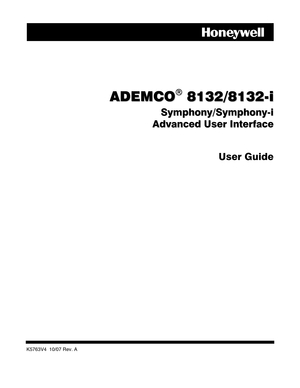
- #Honeywell alarm keypad manual change code how to
- #Honeywell alarm keypad manual change code code
- #Honeywell alarm keypad manual change code download
#Honeywell alarm keypad manual change code how to
Here’s a step-by-step guide on how to replace the battery of your Honeywell alarm system main panel. Just like Honeywell alarm kits, replacing some parts is something you can do yourself. Does it take a tech expert to replace a Honeywell alarm battery? No, it does not. For Honeywell, batteries have to be replaced between 3 and 7 years depending on the unit or model. A busted battery is one of the top causes for alarm system trouble. You have to make sure that all of its elements are being maximized and functioning well.Īmong the main components of a home alarm system is the battery. But technology is only as useful as you want it to be. Its line of alarms and home security systems do more than just protect homes but also connect them. Honeywell, the leading global manufacturer of security solutions, is catering to a new generation of customers with its extensive technology portfolio. This is why home and business owners invest in security systems that are helpful in preventing burglary and other emergencies. When times have become more dangerous, people cannot take chances.

Security is a top concern these days, making it a profitable industry too.
#Honeywell alarm keypad manual change code download
The upload or download session failed before completion. The upload or download session was completed.
#Honeywell alarm keypad manual change code code
The dialer test has been successful (CID code 601). The keypad is not receiving signals from the control sees an open circuit. If the battery standby capacity is used up during a prolonged AC power outage, the control's power will shut down to minimize deep discharge of the battery.

If the message “AC LOSS” (Alpha display keypads) or “NO AC” (Fixed-Word display keypads) is displayed, the keypad is operating on battery power only. Power Failure If there is no keypad display at all and the LEDs are unlit, operating power (AC and battery) for the system has stopped and the system is inoperative. The system is in communication with the central station for change of function or status verification. If this remains displayed for more than 1 minute, the system is disabled. Silence by entering installer code + OFF. Depending on how the system was programmed, the keypad may also produce a trouble sound, and the external sounder may be activated. Telephone Line Failure, indicates that a monitored telephone line (if programmed in field *92) has been cut or disconnected. NOTE: Some wireless sensors contain a non-replaceable long-life battery which requires replacement of the entire unit at the end of battery life (e.g., Nos. If the battery is not replaced within 30 days, a “CHECK” display may occur. With a zone number and a once-per-minute beeping at the keypad indicates that a low-battery condition exists in the wireless sensor displayed (zone “00” indicates a wireless keypad). With no zone number indicates that the system's standby battery is weak. If field *199 is set to “1,” all ECP module problems are displayed as “91.” If there are wireless sensors in the system, the Check condition may also be caused by some change in the environment that prevents the receiver from receiving signals from a particular sensor. Check the wiring and DIP switch settings on the units. Indicates that communication between control and a zone expander or wireless receiver is interrupted, where “xx” is the device address. Indicates that a problem exists with the displayed zone(s) and requires attention.

Also results if an alarm from an exit or interior zone occurs within 2 minutes after the end of an Exit Delay. An “Exit Alarm” message is sent to the central station. The alarm sounder and keypad sound continuously until the system is disarmed (or timeout occurs). No message will be transmitted to the central station.Īppears when Exit Delay ends if an exit or interior zone contained a fault during closing. The alarm sounder and keypad sound continuously, but stop when the system is disarmed.

Will appear if an exit or interior zone contained a fault during closing at the time the Exit Delay ended (e.g., exit door left open), but the system was disarmed during the Entry Delay time.


 0 kommentar(er)
0 kommentar(er)
